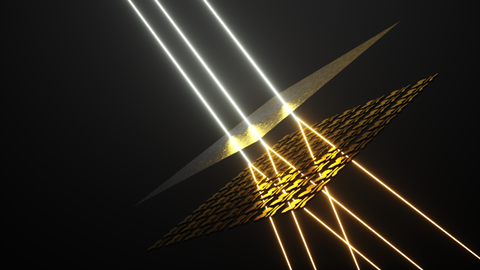AMOLF researchers describe their nanostructured metamaterials that can perform mathematical operations. This provides substantial time and energy savings compared to electronic components.
Researchers from research institute AMOLF in Amsterdam, City University of New York and University of Pennsylvania are developing nanostructures of metamaterials that can solve so-called linear inverse problems. Those problems are among the most common mathematical problems in research areas such as engineering, science and economics. The nanostructure can solve these mathematical problems up to 10,000 times faster than conventional electronic components, said Andrea Cordaro, junior researcher at AMOLF. They published their results this month in Nature Nanotechnology.
The need for efficient computing power that requires much less energy is growing. For some new applications such as artificial intelligence, machine learning and autonomous vehicles, the processing speed and energy efficiency of classical electronics is now a limiting factor. That is why Cordaro and his colleagues are looking for ways to perform calculations with light. We call this optical computing. The input is an image, or light. That light passes through a nanostructure, which then performs the mathematical operation. The output, also an image, is the solution to the equation.
The team developed a thin dielectric nanostructure and combined it with a semi-transparent mirror through which a light signal is continuously reflected back to the nanosurface, causing it to scatter again and again. This corresponds to the iterative operation needed to solve a linear inverse problem. ‘The nanostructure is a glass slide with a thin layer of silicon on top’, Cordaro explains. ‘That layer of silicon has a nanopattern. We design and create the nanopattern such that it performs the desired mathematical operation on light.’ The researchers call it a metamaterial because its precise structure makes it go beyond materials found in nature.
Cordaro’s material could solve a complex mathematical equation in less than a nanosecond. A computer needs a microsecond for the same equation. Cordaro: ‘It is much faster and the material does not consume energy while solving the equation, where electronic components do.’ The research shows a new connection between nanotechnology and analogue computing techniques. ‘This could lead to hybrid computer circuits with both optical and electronic components. In a follow-up study, we could solve even more complex problems with a speed and efficiency impossible with electronic components alone.’














Nog geen opmerkingen